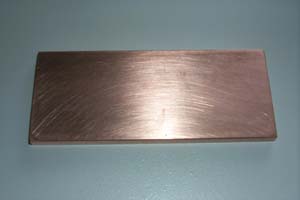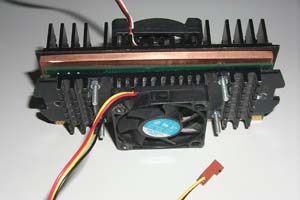

All about hot plate.
 Almost heatsink made of aluminum except
rare pure copper heatsink and Alpha p3125 that has copper in-coperate in back plate.So I desire to evaluate this copper plate.
I spent about one year to find place to buy one.It hardly to find one here.The diamention that I think it proper for most slot 1
is 2*5*1/6 inches.It's weight is about 700 grams that so heavy than Intel's recomendation for heatsink's weight for slot 1.
It cost about 11/2 $ here for each plate,not expensive.After got it,I spent time to lap it for smooth surface as I can.
Lapping it reduce it's crack on the surface.the smooth surface reduce gap between plate and heatsink.
Next step I drilled the copper plate with hand drill to the corresponding holes in the pcb.I used celeron 300a for this test.
Then I installed it together,first I used my big heatsink and sandwich it with AAVID heatsink in the rear and inserted copper plate
between the cpu and heatsink. To complete the test I use small heatsink too made by pc100 and sandwich with AVVID heatsink.
Almost heatsink made of aluminum except
rare pure copper heatsink and Alpha p3125 that has copper in-coperate in back plate.So I desire to evaluate this copper plate.
I spent about one year to find place to buy one.It hardly to find one here.The diamention that I think it proper for most slot 1
is 2*5*1/6 inches.It's weight is about 700 grams that so heavy than Intel's recomendation for heatsink's weight for slot 1.
It cost about 11/2 $ here for each plate,not expensive.After got it,I spent time to lap it for smooth surface as I can.
Lapping it reduce it's crack on the surface.the smooth surface reduce gap between plate and heatsink.
Next step I drilled the copper plate with hand drill to the corresponding holes in the pcb.I used celeron 300a for this test.
Then I installed it together,first I used my big heatsink and sandwich it with AAVID heatsink in the rear and inserted copper plate
between the cpu and heatsink. To complete the test I use small heatsink too made by pc100 and sandwich with AVVID heatsink.
 I tested it and compared when without copper plate.
By recording the tempreture using internal temperature diode in Abit bx6-2.Both in idle time and in mark cpu loaded as Prime 95,the results were
impressive.First I set the bios at 112 FSB to set me celery at 504 MHz .I tried by big heatsink with copperplate first.It passed prime 95 without locking up.
But when without it the system locked up.No usefulness in this setting here because no comparision were done.So reduce the FSB to 100 and ran it again.(
FSB 112 Mhz is the maximum frequency that my chip can run by conventional cooling.)
I tested it and compared when without copper plate.
By recording the tempreture using internal temperature diode in Abit bx6-2.Both in idle time and in mark cpu loaded as Prime 95,the results were
impressive.First I set the bios at 112 FSB to set me celery at 504 MHz .I tried by big heatsink with copperplate first.It passed prime 95 without locking up.
But when without it the system locked up.No usefulness in this setting here because no comparision were done.So reduce the FSB to 100 and ran it again.(
FSB 112 Mhz is the maximum frequency that my chip can run by conventional cooling.)
At 450 Mhz the system could ran through the test.Here are the results.
| Cpu Load/Heatsink Type | Big heatsink | Pc100 heatsink | ||
|---|---|---|---|---|
| w copper | wo copper | w copper | wo copper | |
| at idle | 33 c | 34 c | 36 c | 37 c |
| Prime 95 | 47c | 50 c | 48 c | 56 c |
From The table you can see that with copper plate adding to the heatsink.It helps to cold down the cpu at less 2 c.
when the cpu was in maximun loading with large heatsink.And in Pc 100 heatsink,adding copper plate helped in cold down
the chip as much as 8 c.!!!
 From the results above ,you see the effectiveness of using copper plate in helping cooling down the temperature.If you don't want
to use aggressive cooling system.Adding copper plate to your heatsink cost not much but very effective way to cool down
your chip especially when you use a small or medium one.It worth every bucks you spent .The disadvantage is
its' weight that is so heavy.Choose a thin copper plate one may decrease this results.This is another effective way to cool down
your chip.So let you try it yourself and see what happen to your system!
From the results above ,you see the effectiveness of using copper plate in helping cooling down the temperature.If you don't want
to use aggressive cooling system.Adding copper plate to your heatsink cost not much but very effective way to cool down
your chip especially when you use a small or medium one.It worth every bucks you spent .The disadvantage is
its' weight that is so heavy.Choose a thin copper plate one may decrease this results.This is another effective way to cool down
your chip.So let you try it yourself and see what happen to your system!